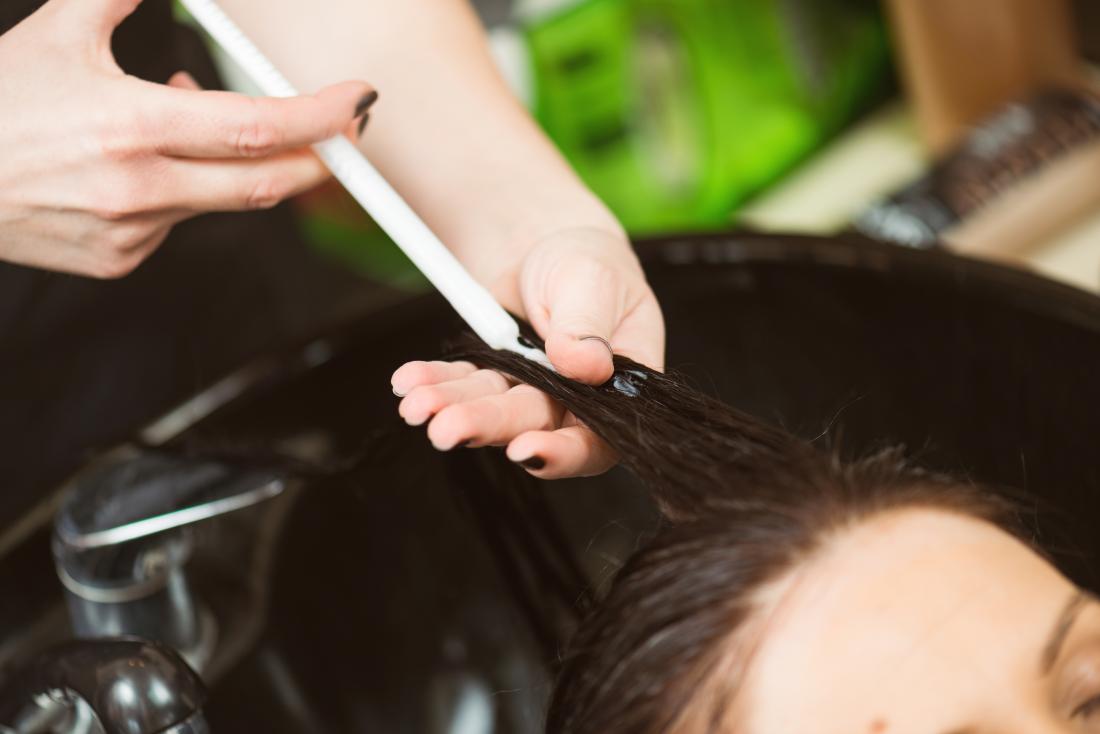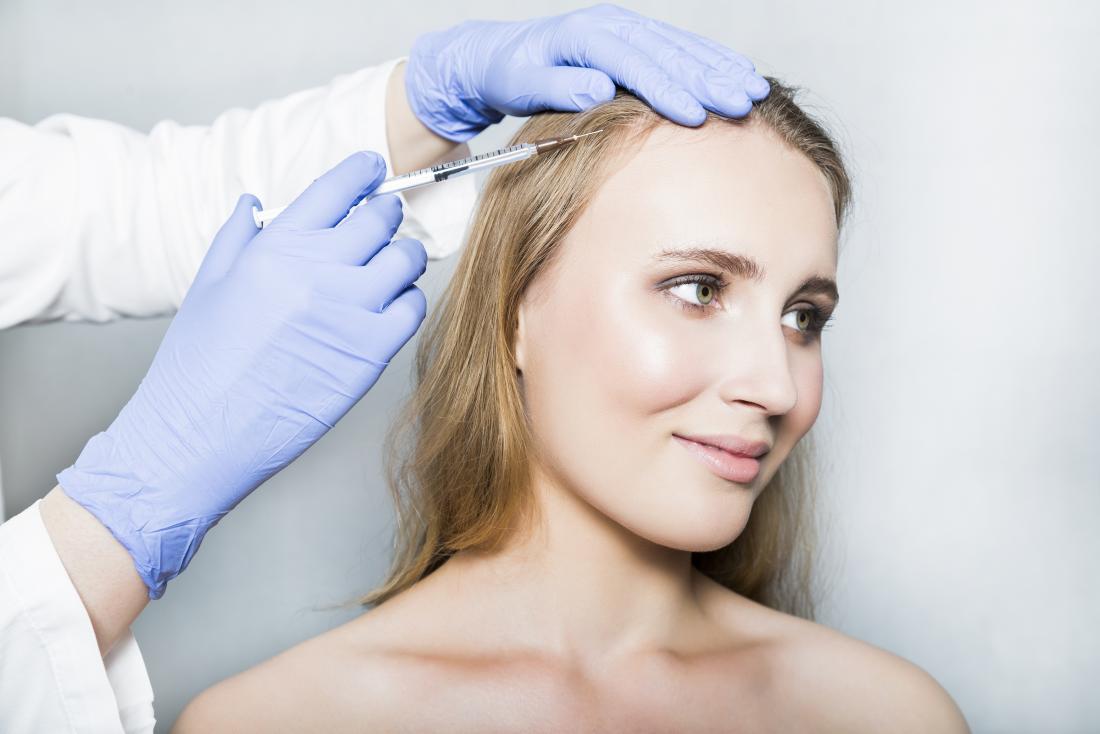What is Botox for hair?

Two types of Botox treatment exist for hair: Botox for hair and injecting botox into the scalp.
Botox has been advertised for use in creating more beautiful hair. Two types of Botox treatments exist.
The first is Botox for hair, which does not contain Botox at all. Instead, it is a topical application designed to “fill in” damaged hair, making it shinier and healthier-looking.
The other application involves injecting Botox into the scalp. This is an off-label use of the Botox product, meaning that the United States Food and Drug Administration (FDA) have not approved it for this purpose.
Botox is a compound made from botulinum toxin, a substance that is known to cause muscle paralysis.
While botulinum toxin can be toxic in large quantities, doctors use it in smaller amounts for several beneficial purposes. These can include reducing sweating, migraine headaches, lazy eye, and swallowing difficulties, as well as for cosmetic purposes.
Who might use Botox for hair?
Topical applications of products marketed as Botox for hair are usually recommended for those who have brittle, damaged, or frizzy hair. People whose hair has been damaged by heat styling and coloring may also benefit from hair smoothing and strengthening treatments.
Botox injections for the scalp are marketed to people who sweat excessively because sweating can cause hair to appear stringy and unclean quickly.
People who get the injections may be able to leave their hair for longer periods between washes. Botox scalp injections are also rumored to boost hair growth, but this has not been proven.
How does Botox for hair work?

A person may not sweat as much when Botox is injected into the scalp.
The idea of Botox for hair comes from the theory that topical treatments can fill in damaged portions of hair, making the hair appear smoother and healthier. The same is true for Botox that is injected into the face to reduce the appearance of lines and wrinkles.
Some of the products that are marketed as Botox for hair include L’Oreal Professionel’s Fiberceutic. This product contains a compound that the company calls “Intra-Cyclane,” which is intended to smooth and plump the hair.
Other companies and hair salons may market a combination of products — such as vitamins, essential oils, and collagen — as Botox for hair.
Repair lotions and treatments for hair are available for purchase online.
When Botox is injected into the scalp, it reduces the work of the eccrine or sweat glands. As a result, a person may not experience such high amounts of sweat.
Botox injections can result in fewer incidences of frizz and the ability to go longer without washing the hair. One of the nicknames for this approach to Botox for hair is “Blotox,” because the injections are reported to extend the life of a blowout.
Risks and considerations
While topical Botox for hair injections are intended to strengthen the hair and improve its appearance, sometimes the opposite occurs.
Most stylists do not recommend using these treatments more than three to four times a year. Otherwise, hair breakage, thinning, and dullness can occur.
There is also a chance that these treatments will not work, and they are very expensive.
Botox injections into the scalp may be a short-term solution to frizz or greasy hair. In the end, the body absorbs the Botox into the system, which means that a person may start seeing less of an effect about 2 to 3 months after the initial Botox injections.
Like topical treatments, Botox injections can be costly. Some treatments can cost more than a $1,000.
Other treatment options

The use of heat on the hair should be reduced to strengthen the hair, as heat styling may weaken and damage it.
Botox is just one of many treatments available to people who want to enhance the appearance of their hair.
Beauty experts consider keratin treatments similar to Botox for hair. These treatments involve applying a special solution to the hair to smooth and strengthen it. Some of the ingredients include keratin and amino acids.
However, some keratin treatments have been investigated because they contain ingredients such as methylene glycol or formalin. These are preservatives that become the compound formaldehyde when heated.
Formaldehyde is a known carcinogen, meaning it can cause cancer. Therefore, these treatments are not healthful for a person.
Other keratin smoothing treatments, such as Liquid Keratin and Organix Brazilian Keratin Therapy, are available at hair salons. Instead of formalin or methylene glycol, these treatments contain a compound known as biformyl.
While researchers do not consider biformyl to be as dangerous as formaldehyde, it can still cause significant irritation to the skin, eyes, and respiratory tract.
People can also purchase keratin and anti-frizzing products at beauty supply stores. Examples include Supersilk Smoothing System and Cezanne Perfect Finish.
Instead of buying these treatments, a person might benefit from several lifestyle changes that can make hair healthier and stronger. These include the following steps:
- Reducing the number of heat stylings, such as curling irons, flat irons, and hair dryers. These can weaken hair and make it more prone to breakage.
- Reducing stress levels. Stress can affect the skin and hair. Stress causes the body to release extra levels of stress hormones, which can lead to hair loss in extreme instances.
- Eating a healthful diet that features a wide variety of fruits and vegetables.
Some people may also wish to take supplements with trace vitamins and minerals known to improve the hair’s appearance. These include biotin, iron, silica, and zinc. However, scientists have not definitively proven that these supplements will help.
Often, if a person practices these self-care techniques at home, they might see improvements in their hair.
Outlook
While Botox has proven a revolutionary product for many health concerns and conditions, the compound has not been definitively proven to help repair or improve hair.
If a person is experiencing profound hair damage or hair loss that does not improve with over-the-counter treatments, they should talk to their healthcare provider.